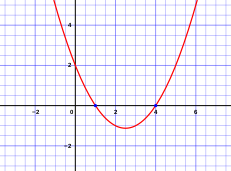Jadhav Quadratic Formula
| Jadhav Quadratic Formula | |
|---|---|
| Modified Conventional Quadratic Formula | |
| Definition | |
| Jadhav Quadratic Formula, evaluates accurate values of numbers lying on x-axis of the co-ordinate plane corresponding to the respective y-axis points. Derived by Indian-Mathematical Scholar Jyotiraditya Jadhav | |
| Details | |
| Indian Invention |
Jadhav Quadratic Formula, evaluates accurate values of numbers lying on x-axis of the co-ordinate plane corresponding to the respective y-axis points. Derived by Indian-Mathematical Scholar Jyotiraditya Jadhav.
Formula[edit]
If we are given the points of y-axis with the quadratic equation it followed then we can find the respective x-axis points by:
here the plus-minus "±" indicated the quadratic equation has two solutions. written separately, they become.
and
Been a quadratic equation each point at a height of y-axis will have two x-axis points, following the rules or discriminant.
Rule[edit]
if then the equation does not have solution in real numbers.
if then the equation have solutions in real numbers.
if then the y-axis point is at the end of the parabola and is at center so has only one solution.
The "Conventional" Quadratic Formula[edit]

In elementary algebra, the quadratic formula is a formula that provides the solution(s) to a quadratic equation. There are other ways of solving a quadratic equation instead of using the quadratic formula, such as factoring (direct factoring, grouping, AC method), completing the square, graphing and others.[1]
Given a general quadratic equation of the form
with x representing an unknown, a, b and c representing constants with a ≠ 0, the quadratic formula is:
where the plus-minus symbol "±" indicates that the quadratic equation has two solutions.[2] Written separately, they become:
Each of these two solutions is also called a root (or zero) of the quadratic equation. Geometrically, these roots represent the x-values at which any parabola, explicitly given as y = ax2 + bx + c, crosses the x-axis.[3]
As well as being a formula that yields the zeros of any parabola, the quadratic formula can also be used to identify the axis of symmetry of the parabola,[4] and the number of real zeros the quadratic equation contains.[5]
Proving the "Constant method"[edit]
Jadhav Quadratic Formula also proves the "Constant method" of Conventional Quadratic Formula. If the equation was equated to some value of y non-zero then the new constant becomes and we can even apply conventional quadratic formula to it of constant c been which becomes Jadhav Quadratic Formula.
Requirements[edit]
For this formula to function we should have the quadratic equation along with given y-axis point and can get the 2 corresponding points on the x-axis.
Nomenclature[edit]
- b: Coefficient of .
- a: Coefficient of .
- c: Constant term of equation.
- y: The given y-axis point.
Historical Note[edit]
This Formula is made by Jyotiraditya Abhay Jadhav, an Indian Mathematical-Scientist. The story revolves of him been trying to derive Quadratic Formula with different methods of divisional process and thought of other values of y-axis instead of 0 (roots of quadratic equation) and denoted it with "y" and later derived to this equation of equating value of "x" to respective coefficient of the equation with "y".
Derivation[edit]
Let the quadratic equation be :
Now at some given value of x the function of graph will give the value for point lying on y-axis
So, we can equate
(dividing all terms by a)
(adding on both sides)
Deriving the Jadhav Quadratic Formula.
- ↑ "Quadratic Factorisation: The Complete Guide". Math Vault. 2016-03-13. Retrieved 2019-11-10.
- ↑ Sterling, Mary Jane (2010), Algebra I For Dummies, Wiley Publishing, p. 219, ISBN 978-0-470-55964-2
- ↑ "Understanding the quadratic formula". Khan Academy. Retrieved 2019-11-10.
- ↑ "Axis of Symmetry of a Parabola. How to find axis from equation or from a graph. To find the axis of symmetry ..." www.mathwarehouse.com. Retrieved 2019-11-10.
- ↑ "Discriminant review". Khan Academy. Retrieved 2019-11-10.


















![{\displaystyle [{x+b/2a}]^{2}+c/a=y/a+b^{2}/4a^{2}}](https://wikimedia.org/api/rest_v1/media/math/render/svg/20c2ac9fe58733ac7e247674829e4c613c8779ae)
![{\displaystyle [{x+b/2a}]^{2}=y/a+b^{2}/4a^{2}-c/a}](https://wikimedia.org/api/rest_v1/media/math/render/svg/8d201b3d7fac555f310991abd934ea746b1f786e)
![{\displaystyle x+b/2a=\pm \surd [y/a+b^{2}/4a^{2}-c/a]}](https://wikimedia.org/api/rest_v1/media/math/render/svg/8c3812f07a86b2abd72672174878eb9a7c70ba22)
![{\displaystyle x+b/2a=\pm \surd [4ay+b^{2}-4ac]/\surd \left\vert 4a^{2}\right\vert }](https://wikimedia.org/api/rest_v1/media/math/render/svg/46c2d2b0c050432c2b08a98aef8deda4e1d23905)
![{\displaystyle x=-b/2a\pm \surd [4ay+b^{2}-4ac]/\surd \left\vert 4a^{2}\right\vert }](https://wikimedia.org/api/rest_v1/media/math/render/svg/ab13165702e4ba609f668bdbcdc72a06ed2f4c13)